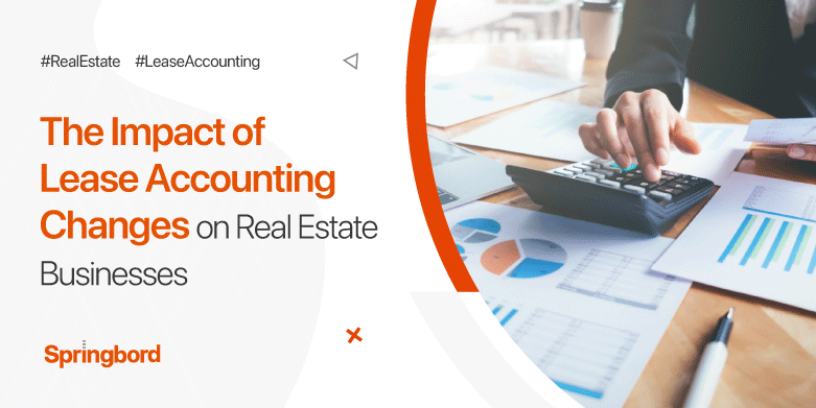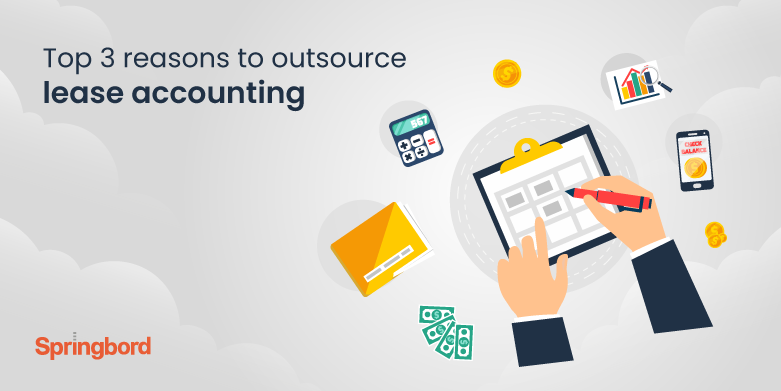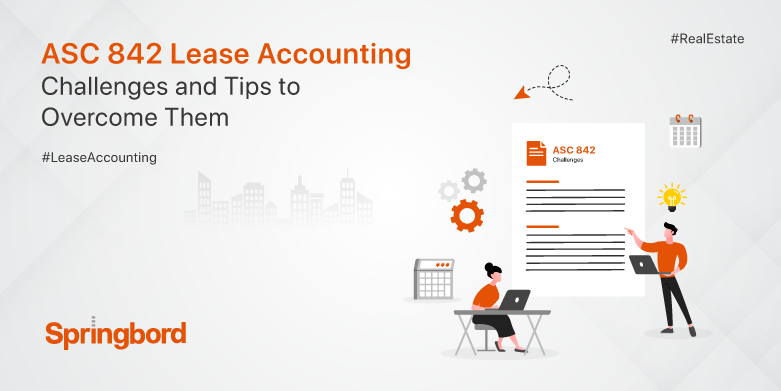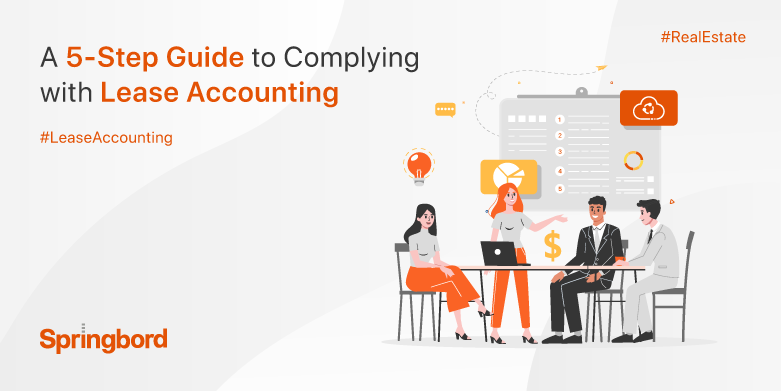 Read time 8 min
Read time 8 minThe impact of lease accounting changes on real estate businesses has been substantial, affecting their financial reporting, decision-making processes, and overall operations. Significant lease agreement recognition, measurement, and reporting changes have resulted from implementing new lease accounting standards.
These changes have resulted in greater transparency and accuracy in lease reporting, but they have posed challenges for real estate businesses. This article examines the impact of lease accounting changes, concentrating on property accounting, and identifies the challenges and opportunities they present to real estate professionals.
Overview of Lease Accounting Changes
Corporations have widely used leases to gain access to assets without taking on the full financial responsibility of ownership. Historically, lease accounting has been subject to a wide range of standards, which has resulted in inconsistent and opaque reporting procedures.
In response to concerns about the opacity and potential misrepresentation of financial statements, the International Accounting Standards Board (IASB) and the Financial Accounting Standards Board (FASB) introduced new lease accounting standards.
- Previous lease accounting standards:
Leases were previously divided into two categories under the old lease accounting standards: operating leases and finance leases. Financial reporting transparency and comparability issues arose because operating leases were not recognized as assets or liabilities.
Companies may have had their financial position skewed because they could conceal substantial leasing liabilities. As a result, stakeholders such as investors and analysts need help understanding a company’s finances and risk profile.
- The new lease accounting standards:
The International Accounting Standards Board (IASB) and the Financial Accounting Standards Board (FASB) responded to the shortcomings of the existing rules by establishing new lease accounting standards (IFRS 16 and ASC 842, respectively).
Concerns about off-balance-sheet lease accounting were the impetus for creating these guidelines intended to increase the openness of financial reporting.
- Key changes and differences between old and new standards:
- Balance sheet recognition: The most significant change brought by the new standards is that all leases, including operating leases, must now be recognized on the balance sheet.
This means that both the lessee and the lessor must disclose their lease assets and liabilities, giving a more complete picture of the organization’s financial health.
- Lease classification: According to previous regulations, leases were divided into operating and finance categories. The new regulations, on the other hand, take a more principled approach, emphasizing whether or not the lessee acquires the right to govern the use of the underlying asset during the lease term.
This modification does away with the distinction between operating and capital leases and places them on the balance sheet.
- Impact on financial ratios: The recognition of operating leases on the balance sheet will likely affect financial ratios such as debt to equity, leverage ratios, and return on assets. Variations in these ratios may affect a company’s creditworthiness and borrowing rates if it has a sizable portfolio of leases.
- Lease expense presentation: The presentation of leasing expenses changes due to the new rules. Previously, operating lease expenses were included in operating expenses on the income statement.
Since lease costs are now broken down into two categories—amortization of the lease liability and interest expense—the timing and pattern of expenditure recognition have shifted.
Impact Of Lease Accounting Changes On Real Estate Businesses
The impact of lease accounting changes on real estate businesses goes beyond mere compliance with accounting standards. It affects various aspects of financial reporting, performance evaluation, and decision-making within the real estate industry.
- Increased transparency in lease reporting: Transparency in lease reporting for real estate companies has improved thanks to adopting IFRS 16 and ASC 842, the new lease accounting standards. Lessors and lessees can more accurately reflect their lease-related assets and liabilities due to the mandated recognition of all leases on the balance sheet.
Investors and analysts may benefit from this increased openness since they can better comprehend the company’s lease obligations, lease lengths, and risks related to leasing activities. As a result, it facilitates more accurate risk assessment and decision-making.
- Changes in financial statement presentation and ratios: The new lease accounting regulations have dramatically altered financial statement presentation for real estate companies.
In contrast to the previous practice, when operating leases were treated as a single line item on the income statement, the new guidelines require lessees to break down their lease costs into separate lines for depreciation of the underlying asset and interest on the loan.
Adding lease assets and liabilities to the balance sheet also affects vital financial ratios. For instance, if lease payments are included, the debt-to-equity ratio could rise, giving the impression that the company is more financially leveraged than it is.
Investors’ opinions of a company’s financial performance and efficiency may be affected by changes to the ROA and ROE ratios resulting from the recognition of right-of-use assets.
- Impact on financial performance and profitability: The impact of lease accounting changes on real estate businesses’ financial performance and profitability is multifaceted.
There may be an impact on credit ratings and borrowing costs following the initial reporting of lease liabilities on the balance sheet. Companies that rely primarily on leasing to fund operations or expansion may be negatively impacted.
Furthermore, the variations in reported earnings over the lease period may be due to the changes in expense recognition.
Profitability may be lower than under the old accounting standards when interest expenses are high at the beginning of a lease. However, profitability may increase later since interest expenses decrease throughout the lease.
- Effects on real estate investment decisions and strategies: The lease accounting revisions will significantly affect how investors approach and use real estate. If a real estate company’s primary source of income is the leasing of properties, fluctuations in its financial metrics could reduce its appeal to investors and lenders.
The influence of lease accounting modifications on key financial ratios and profitability measurements should be considered by investors when assessing the health and performance of real estate firms.
The new rules for deducting lease costs could affect lease pricing and structure. The financial impact of the new accounting rules may necessitate changes in lease conditions, such as lease duration and payment arrangements, for real estate enterprises and property owners.
The influence on financial ratios and lease-related expenses may also prompt a reevaluation of lease-versus-buy evaluations to find the most cost-effective method of obtaining assets.
Challenges and Opportunities for Real Estate Businesses
The challenges and opportunities brought about by the impact of lease accounting changes require real estate businesses to adapt their lease management practices and financial strategies.
Businesses may better negotiate the complexity and take advantage of the benefits of lease accounting changes if they embrace new technologies, practice open communication, and make smart decisions.
- Identifying and assessing lease contracts accurately: One of the primary issues real estate organizations confront with introducing new lease accounting standards is the accurate identification and evaluation of lease contracts. The accounting for leases can get complicated when parties to a lease agree to various arrangements, appendices, and concessions.
Businesses should thoroughly evaluate their leasing portfolio to guarantee that all applicable contracts are documented and categorized accurately under the new rules.
To arrive at a reliable assessment of lease terms, lease revisions, and lease extensions, it may be necessary for members of the financial, legal, and real estate departments to work together.
This situation allows real estate firms to standardize and consolidate their lease management procedures despite the difficulty. Businesses can improve the precision and efficacy of their lease data management by using standardized lease templates and employing powerful lease administration software.
- Adopting new accounting software and systems: Transitioning to the new lease accounting standards often requires implementing new accounting software and systems that can handle the complexities of lease calculations and reporting.
This is problematic for the real estate industry, especially for smaller companies or those using antiquated technology. It can be expensive to teach employees how to use new software and take time to implement it.
On the other hand, transitioning to modern accounting software can improve efficiency and productivity. Modern lease accounting solutions may streamline the gathering of lease information, streamline the monitoring of lease payments, and produce reliable financial reporting.
Real estate companies may increase data quality, reduce manual errors, and speed up the lease management process by utilizing technology.
- Addressing potential conflicts with stakeholders: The shift to the new lease accounting standards can lead to conflicts with stakeholders, such as tenants, landlords, investors, and lenders.
For instance, tenants of commercial real estate may worry that, due to shifts in the timing and pattern of expense recognition, their leasing costs may rise. Landlords may also have to negotiate with renters over the monetary effects of the new lease accounting laws.
Open dialogue is essential for resolving any disputes that may arise. Proactive communication with stakeholders by the real estate industry is essential to clarify the implications of lease accounting changes and provide clarification about any modifications to lease terms or pricing.
Having everyone on the same page about the monetary effects of the accounting adjustments is essential to building trust.
Property Accounting under New Lease Standards
Property accounting under the new lease standards involves recognizing and measuring property leases on the balance sheet and carefully treating variable lease payments and lease modifications.
- Property lease accounting principles: The new lease accounting standards, IFRS 16 and ASC 842, have introduced significant changes to property lease accounting. Property leases, such as those for land, buildings, and other real estate, are subject to these guidelines.
Property lease accounting necessitates recognizing and reporting lease transactions on the financial statements to portray a company’s lease-related assets and liabilities accurately.
- Recognition and measurement of property leases: Under the new lease standards, lessees must recognize a right-of-use (ROU) asset and a corresponding lease liability on the balance sheet for all property leases, regardless of duration.
The ROU asset represents Lessee’s right to use the property during the lease term, while the lease liability represents the Lessee’s duty to make lease payments.
The ROU asset and lease liabilities are initially calculated using the lessee’s incremental borrowing rate to discount future lease payments to their present value. By taking this route, you may rest assured that the values you see in the books accurately reflect the true worth of your lease when it first begins.
- Treatment of variable lease payments and lease modifications: Property lease accounting can be complicated by lease payments that fluctuate based on factors like operating expenses, property taxes, or a tenant’s ability to pay a certain amount each month.
Lease payments based on an index or a rate are not included in the initial liability measurement under the new rules. Instead, they are included in earnings in the reporting period that includes the occurrence of the event or condition that warrants the payment.
Additionally, any lease modifications made after the start date must be evaluated to ascertain whether they constitute a new lease or an amendment to the current lease.
Lessee may need to reassume the lease liability and ROU asset, adjusting for the change in lease terms if a modification changes the scope of the lease.
To Sum Up
The impact of lease accounting changes on real estate businesses is undeniable, ushering in a new era of transparency and financial reporting. Businesses need assistance from reliable information service providers like Springbord as they manage the complexities of the new lease rules.
As a prominent global information service provider, Springbord understands the specific requirements of different sectors and develops data-collecting and processing solutions accordingly.
Springbord equips enterprises in the commercial and public sectors with dependable business process outsourcing services by leveraging state-of-the-art Internet-based capabilities and substantial resources.
Businesses in the real estate industry may optimize their financial performance and decision-making with the help of Springbord as they confidently adapt to the changing lease accounting landscape.







